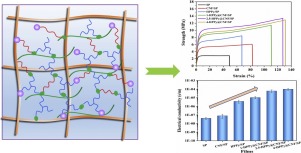Carbohydrate Polymers ( IF 11.2 ) Pub Date : 2020-03-09 , DOI: 10.1016/j.carbpol.2020.116141 Shicun Jin , Kuang Li , Qiang Gao , Wei Zhang , Hui Chen , Jianzhang Li

|
Smart conductive soft materials prepared from natural polymers are arousing ever-increasing attention in numerous advanced applications. However, achieving the synergistic properties of high biocompatibility, mechanical performance, and conductivity remains a key challenge. Herein, a novel and green strategy is proposed to fabricate a soy protein (SP)-based composite by the incorporation of hyperbranched poly(amino ester)-pyrrole (HPPy) via in situ polymerization into a bio template of cellulose nanofibril (CNF). The formed HPPy@CNF nanohybrids not only serve as dynamic cross-linking sites to construct a strong and stable network, but also impart a remarkable conductive ability to biopolymer materials. The tensile stress and toughness of the modified SP-based film increased by 362.1 % and 718.8 %, respectively superior to those of previously reported reinforcing approaches. Moreover, this biopolymer film exhibited significantly improved electrochemical properties, water resistance, and thermal stability. This synthesis strategy is facile and eco-friendly and can be easily extended to other material systems.
中文翻译:

纤维素纳米原纤模板定向超支化共聚物增强导电蛋白基薄膜的研制
由天然聚合物制成的智能导电软材料在众多高级应用中引起了越来越多的关注。然而,实现高生物相容性,机械性能和电导率的协同性能仍然是关键挑战。在本文中,提出了一种新颖的绿色策略,该方法是通过原位聚合将超支化的聚(氨基酯)-吡咯(HPPy)掺入到纤维素纳米原纤维(CNF)的生物模板中来制造基于大豆蛋白(SP)的复合材料。形成的HPPy @ CNF纳米杂化物不仅充当动态交联位点以构建强大而稳定的网络,而且还赋予生物聚合物材料非凡的导电能力。改性SP基薄膜的拉伸应力和韧性分别提高了362.1%和718.8%,分别优于先前报道的加固方法。此外,该生物聚合物膜表现出显着改善的电化学性能,耐水性和热稳定性。这种合成策略既简便又环保,可以轻松扩展到其他材料系统。


























 京公网安备 11010802027423号
京公网安备 11010802027423号